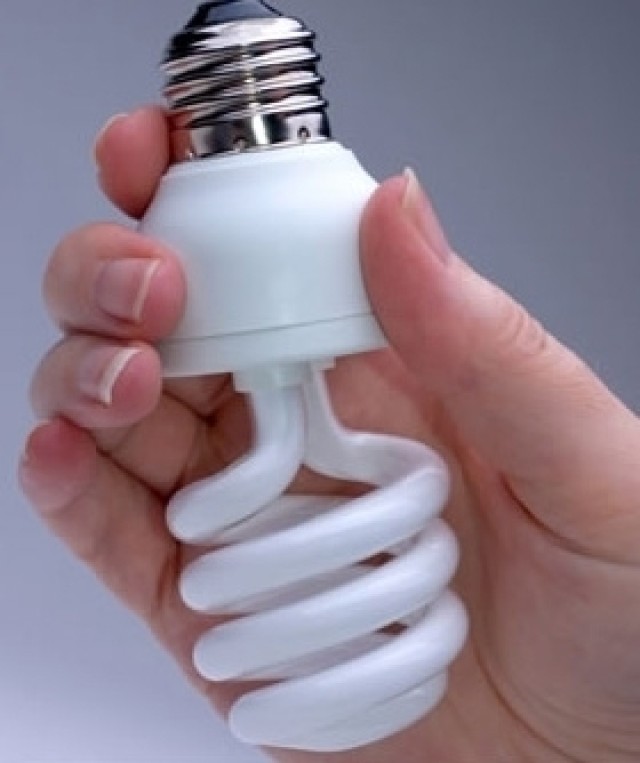GRAFENWOEHR, Germany - In 1992 Dieter Bauernschmitt, with little fanfare, unscrewed a blown light bulb from his living room ceiling and replaced it with a brand new bulb.
After nearly a decade and a half of use, and after having been switched on and off daily for several hours, the bulb finally gave out last year.
Again, he replaced the bulb with an energy-saving, long-life compact fluorescent light bulb - one he hopes will last him another 15 years.
"It was a minor experiment I did at home myself," he recalled, smiling as remembered using a CFLB for the first time.
Why the test' "I was a chemist at the time and very interested in saving raw materials, energy," explained Bauernschmitt, who is U.S. Army Garrison Grafenwoehr's pollution prevention manager, working to reduce pollution and resource consumption throughout the community.
The idea, Bauernschmitt said, was to determine if a CFLB could actually save the amount of energy and money that its proponents had claimed. His first purchase of a CFLB in 1992 cost 30 German marks (approximately 15 Euro today), an extremely high price for one light bulb, but it has saved him hundreds of Euros in energy savings during the last decade.
Similarly, USAG Grafenwoehr itself is working to save money, too, as it switches standard incandescent light bulbs with CFLBs. So far, Bauernschmitt and his team have replaced about 1,000 of the 3,000 outdoor bulbs in nearby Vilseck housing areas.
And in a very short period of time - since May 2006 - it is has begun to pay off, to the tune of about $40,000 annually.
"And this is a very conservative estimate," Bauernschmitt said, adding that as additional funding becomes available, the garrison's environmental division will continue replacing incandescent bulbs throughout Grafenwoehr and Vilseck to net even greater savings.
The $40,000 savings is a significant dent in the garrison's electric bills, which total $13 million at Grafenwoehr and $12 million in Vilseck.
Therefore, Bauernschmitt and his colleagues are encouraging residents to replace their old incandescent bulbs with CFLBs. In fact, military identification cardholders who live on post or in government-leased housing off post can get CFLBs for free at the installation Self Help store.
Residents who live off post in non-government leased housing will have to purchase their own bulbs, which can be found on the economy or in the post commissary and shoppettes. And while the upfront cost for CFLBs is more expensive, ranging in price from $8-$12 a piece, Bauernschmitt said the lifetime savings in money and energy are striking and worthwhile.
For example, by replacing one incandescent bulb in a home with a CFLB, residents can save roughly $61 over the bulb's lifetime.
And besides the fact that one CFLB is expected to burn for 15,000 hours (incandescent bulbs last for about 1,000 hours) and uses significantly lower amounts of energy, Bauernschmitt noted people may also see a decrease in their cooling bills.
"A normal incandescent bulb is an oven," he said. "It has a thread inside ... which is heated up by the electricity. It glows, like a heater in winter time."
Ninety-five percent of the energy consumed by a regular incandescent light bulb produces heat, not light, making it an inefficient light source. Only 5 percent of this heating devise is emitting light, he pointed out.
CFLBs, however, are designed to produce light, not heat.
Overall, energy savings is an Army-wide program that is likely to have an effect on all servicemembers wherever they find themselves stationed.
Back stateside, military families who live in Residential Communities Initiative housing may have to pay their own electric costs when usages go over a predetermined amount. Families are allotted a certain amount of money in a servicemember's pay for utilities costs. In hopes of encouraging military members to become more energy conscious, when the usage is higher than the predetermined amount, residents will foot the remainder of the bill.
According to the RCI Web site, RCI will conduct mock billing for up to one year at each installation, during which time they will provide residents information regarding their consumption and costs as compared to the allowance appropriate for each home. During mock billing, residents will not be responsible for paying any overages or receive payments for savings.
After that phase, actual billing will start.
Residents who conserve at certain levels may have the opportunity to receive a payment or credit; those who do not conserve will be required to pay for excess consumption. The utilities consumption base line will be adjusted annually and usage will also be compared to similar housing off post in the surrounding community to make any necessary adjustments or enhancements to the program, according to RCI's Web site.
While the Army in Europe is not participating in the RCI program, officials are hoping residents will choose to curb energy usage on their own. Baurernschmitt said using CFLB is a smart, easy way to start, as "Earth has only a limited amount of natural resources ... and to produce electricity, you have to burn a lot of crude oil. We have children (who will be living) on this planet for the next 50 or 100 years."
(Adriane Foss is a member of the USAG Grafenwoehr Public Affairs Office)


Social Sharing